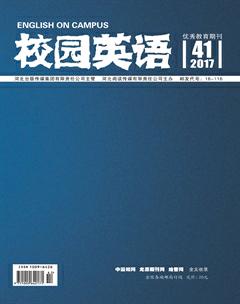On China’s National Image Building in America
刘丽妍
【Abstract】All states big or small live interdependently where no state is self-sufficient in practical terms. However, all states are not equally vulnerable and sensitive towards issues that are of common concern in their interrelationships. The term image seems simple word but it is not. It is complex concept of communication that embraces various issues and factors in inter-state relations.In international communication, cultural differences often lead to misunderstandings and conflicts. American media practitioners understand and report the events that occur in China with the view of American cultural assumptions and values.
【Key words】national image; international communication; culture
A national “image” is created by many different kinds of short pieces of knowledge, which are gained directly and indirectly over long periods of time. But a national image is not fixed;rather, through the course of time, it is renewed by different factors.
According to Edward T. Hall, man is a piece of the cultural fabric into which he is woven. Culture is mans medium;there is not one aspect of human life that is not touched and altered by culture. Culture influences behavior in the deepest and most subtle ways. Man even is a prisoner of his culture. With mass media people can reach more information in a faster and easier way. However, people now are too much relying on mass media and are confined by them.
In international communication, cultural differences often lead to misunderstandings and conflicts. American media practitioners understand and report the events that occur in China with the view of American cultural assumptions and values. It is very easy and natural to look at things from ones own point of view and to read an event as though it were the same all over the world. Every culture has its own characteristics and there is no culture better than another. The media misunderstandings are the result of failure of cross cultural communication. It is difficult for the U.S. media to transform their negative coverage of China into a positive one. The reasons of such reporting are complicated and deeply rooted in the American culture and history. China can make efforts to improve its image in the Western media.
A deeper understanding of the nature of cultural differences between China and America would increase the effectiveness of communication. If Chinese values and western values do have some sort of deep seated, irresolvable mis-alignment, then maintaining a constant dialogue will be the only way to stop small frictions from starting fires. A clearer understanding of China will help avoid turning the cultural misunderstandings into real conflicts.endprint
A lack of deep, nuanced understanding makes foreigners who want to interact with China vulnerable to dangerous miscalculations. In the commercial world firms and individuals constantly make costly mistakes because of analysis based on over-simplified ideas about contemporary china. Given the potentially vital role China can play in maintaining a peaceful international order, this misunderstanding of China is as dangerous for the world as it is for China.
To build the image of the country there is a need to essentially plan for mobilizing the strategies, activities, investments, innovations and communications of as many national sectors as possible, both public and private, in a concerted drive to prove to the world that China deserves a different, broader and more positive image.
Innovative China is not simply the millennias-old culture generally associated with the name on the door. In every instance, China must communicate clearly about her national goals and listen to how those goals will have an impact on the rest of the world. In an interconnected world, China must rely on the good will of a global marketplace of ideas and good. The good will rests on how much China is trusted and how well she is understood. Finding ways to cultivate this trust and understanding should be a national priority for China.
References:
[1]Hansen,Anders,mass communication Research Methods.New York:New York University Press,1998.
[2]Larry Richard Jordan,Always and Forever,2000.
[3]Shoemaker,Pamela and Akiba A.Cohen,News Around the World:Content,Practitioners and the Public,New York:Routledge. 2006.endprint

